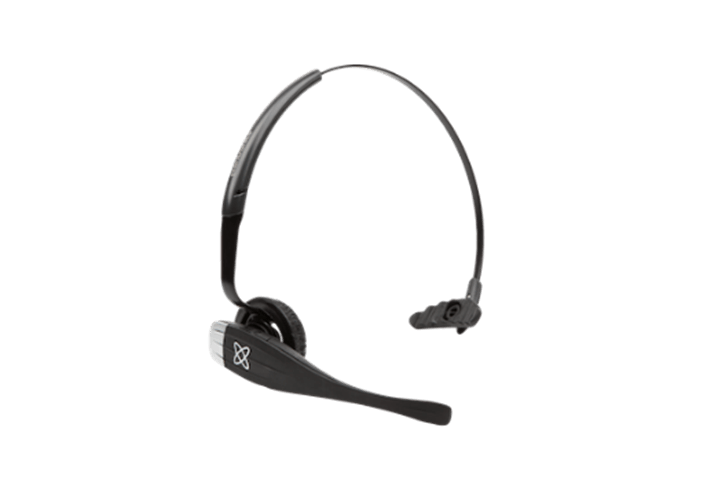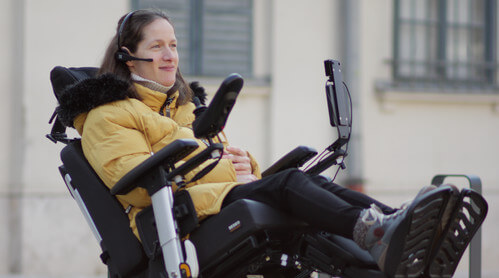Teilen:
Take it offline!
This Education in Motion resource is also available as a printable PDF.
Download PDF
Head controls for powered wheelchairs: a little background
Head and neck-based powered wheelchair control systems have existed almost as long as powered wheelchairs themselves. Rooted in environmental controls of the 1960’s (1), pneumatic or ‘sip and puff’ technology allows operation of assistive technology using only a series of defined breath inputs into a straw (2). The breath inputs act as 4 switches to operate the chair (3). Still in use, this this system requires good breath control, patience to learn the non-proportional chair movements (yes/no in a specific direction rather than gently graded control through 360 degrees) and some find the presence of a straw intrusive. Soon after, various versions of chin controls allowed a fully proportional joystick to be mounted at chin level, for more intuitive control that responded in speed and direction precisely to joystick movements. (4) Yet, this can still be difficult. Chin controls can slip out of place, be uncomfortable, fatiguing or irritate the skin.
Later, head arrays like such as the Switch-It switched head array allowed wheelchair operation with no equipment in front of the driver’s face. They had the additional benefit of positive impacts on head control in some cases. But, the proportionality of a chin control was lost. More recently, headrest-based head controls that use independently programmable force and proximity sensors, like the Dual-Pro provide fully proportional, nuanced control.
As innovative as this most recent generation of head arrays have been, they also have limitations. Although consistent positioning is generally easier with a head array than a chin control, they can still be pulled out of place on hoists, or with rough handling. Clients who shift their head position significantly in the day can slip of alignment needed to control their wheelchairs. Lateral headrest pads can provide a period of rest, but also appear bulky.

Bluetooth wireless headset option: The Switch-It Vigo
A new type of fully wireless headset-style wheelchair control enables completely wireless wheelchair operation. Using Bluetooth technology, it allows operation of the wheelchair and seating functions.
How does it work?
The Switch-It Vigo uses a gyroscope and Bluetooth to provide a wireless, proportional head controller incorporated into a headset. Small gyroscope sensors measure head movements in three dimensions. The headset then transfers this information via Bluetooth to a small receiver that attaches to the Omni 2 wheelchair control display screen. This display screen is used commonly with all special input devices on Sunrise Medical wheelchairs. This information on head movements enables full proportional driving. It also can control a mobile phone with Bluetooth, like the other controls, but has the addition of a small microphone in the headset for clear voice reception. The Vigo has proprietary software for custom programming fine-tuning, via a USB dongle plugged into a computer. This same dongle allows the wearer to operate a computer mouse, even without any further programming of the general wheelchair control system, like other special input devices require.
How is it pronounced?
Vēgo It is pronounced using a long e sound. Although our UK author noted that Britain likes to go a bit rogue at times, so Vigo rhyming with ‘I go’ happens too.
Who would use a Vigo head controller?
Much like other head control options, someone who has fair to good head control without pain, but is not able to use an extremity to control a joystick could find they have independent wheelchair operation with a Vigo.

It offers the additional benefit of being able to recalibrate during the day, so even if the individual shifts position, the wheelchair still functions well. It works on small, gentle movements, so is best suited for people with good coordination.
Although it can work on very subtle movements, the driver needs to have consistent movement without pain in cervical flexion/extension and lateral cervical flexion in each direction. It is a lightweight unit separate from the chair, so eliminates concerns of being pulled about by family, assistants or others. Once the headrest is separate from the chair its lightness means it needs to be put in a safe spot to prevent damage, so there needs to be a routine to ensure it will be stored safely. It also needs to have the batteries charged nightly (via standard mini-USB). Some examples of diagnoses of people who have been successful with the Vigo are:
- Spinal cord injuries SCI
- Cerebral Palsy CP
- Multiple Sclerosis MS
- Traumatic Brain Injury TBI or Stroke
- Peripheral Nerve injuries
- Amyotrophic Lateral sclerosis ALS/ Motor Neurone Disease MND

What other clinical considerations are there?
Since the Vigo does not include a head support, it is important to ensure that the wheelchair has a good fitting head support. This provides the option to rest when the chair is not in use and for orientation when driving the chair. Since the Vigo uses right and left lateral flexion to turn the chair, consider a headrest with lateral cervical support (side neck pads) for comfortable use over long periods, like the Whitmyer S.O.F.T range.

Whitmyer S.O.F.T. 3 Pad system with lateral cervical pads
So, if your client needs a head control, wants a low-profile option with no wires and easy computer connectivity, the new Vigo is a control to consider.
Want to know more about how the Vigo works? Take a look at our article all about the system components and how they work together.